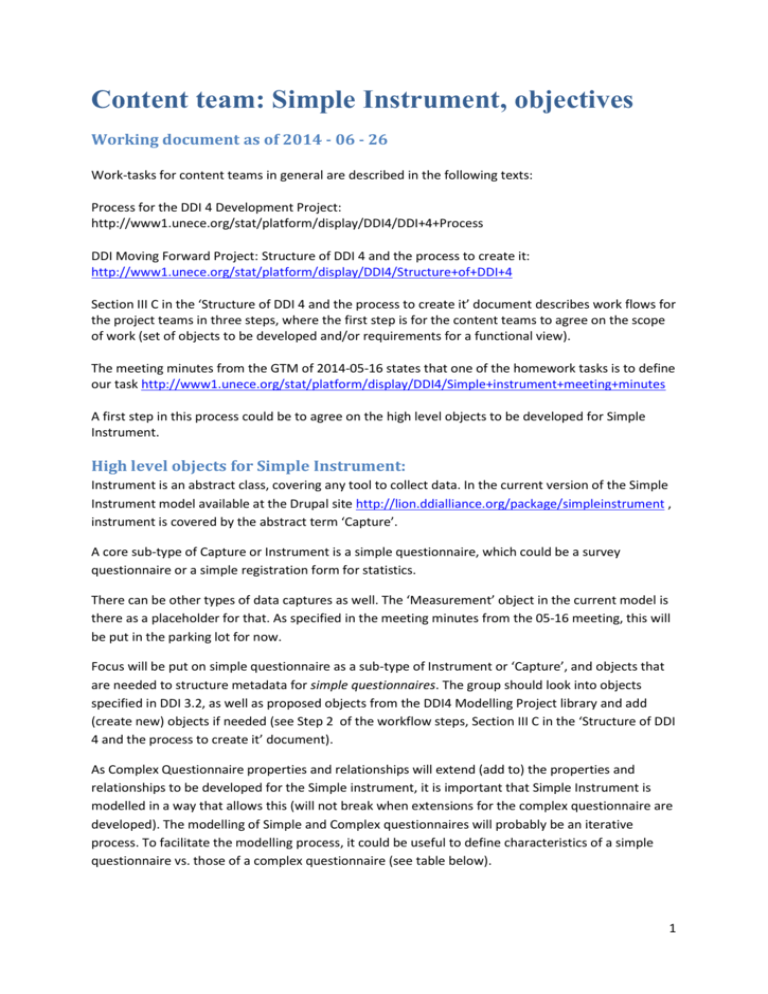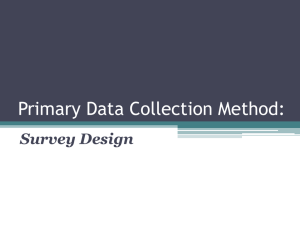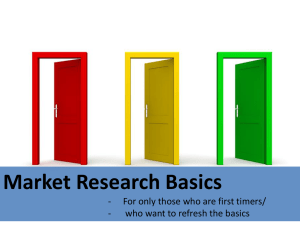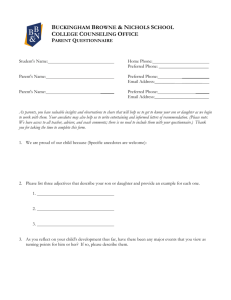Simple instrument objectives - Working document 20140909
advertisement

Content team: Simple Instrument, objectives Working document as of 2014 - 06 - 26 Work-tasks for content teams in general are described in the following texts: Process for the DDI 4 Development Project: http://www1.unece.org/stat/platform/display/DDI4/DDI+4+Process DDI Moving Forward Project: Structure of DDI 4 and the process to create it: http://www1.unece.org/stat/platform/display/DDI4/Structure+of+DDI+4 Section III C in the ‘Structure of DDI 4 and the process to create it’ document describes work flows for the project teams in three steps, where the first step is for the content teams to agree on the scope of work (set of objects to be developed and/or requirements for a functional view). The meeting minutes from the GTM of 2014-05-16 states that one of the homework tasks is to define our task http://www1.unece.org/stat/platform/display/DDI4/Simple+instrument+meeting+minutes A first step in this process could be to agree on the high level objects to be developed for Simple Instrument. High level objects for Simple Instrument: Instrument is an abstract class, covering any tool to collect data. In the current version of the Simple Instrument model available at the Drupal site http://lion.ddialliance.org/package/simpleinstrument , instrument is covered by the abstract term ‘Capture’. A core sub-type of Capture or Instrument is a simple questionnaire, which could be a survey questionnaire or a simple registration form for statistics. There can be other types of data captures as well. The ‘Measurement’ object in the current model is there as a placeholder for that. As specified in the meeting minutes from the 05-16 meeting, this will be put in the parking lot for now. Focus will be put on simple questionnaire as a sub-type of Instrument or ‘Capture’, and objects that are needed to structure metadata for simple questionnaires. The group should look into objects specified in DDI 3.2, as well as proposed objects from the DDI4 Modelling Project library and add (create new) objects if needed (see Step 2 of the workflow steps, Section III C in the ‘Structure of DDI 4 and the process to create it’ document). As Complex Questionnaire properties and relationships will extend (add to) the properties and relationships to be developed for the Simple instrument, it is important that Simple Instrument is modelled in a way that allows this (will not break when extensions for the complex questionnaire are developed). The modelling of Simple and Complex questionnaires will probably be an iterative process. To facilitate the modelling process, it could be useful to define characteristics of a simple questionnaire vs. those of a complex questionnaire (see table below). 1 Simple Instrument vs. Complex Instrument, characteristics No. 1 2 3 4 Characteristics Simple Instrument Simple survey questionnaire, simple registration form Characteristics Complex Instrument Complex survey questionnaire, complex registration form In or Out – to be considered in an instrument model, whether simple or complex. IN Several questionnaire modules Several questionnaire modules IN Includes single questions Includes question batteries Includes single questions Includes question batteries IN IN Comment SK: This specific exercise is focused on the simple instrument questionnaire. “Capture” can include other forms of instruments, but those should be treated separately from the simple instrument questionnaire. SK and HO: A questionnaire module is a section of a questionnaire, developed to measure a (high level) research concept. Examples of modules: http://www.europeansocialsurve y.org/data/module-index.html HO and SK: Questions can include general (study and/or mode independent) and study and/or mode dependent components. It could perhaps be useful to implement the distinction between represented question and instance question objects in the model. If it is possible to have this distinction in complex instrument without including it in simple instrument too, then we could park this for now and revisit it when discussing Complex Instrument. BR: Discuss in particular with Jannik HO: definition: section of request for an answer texts (questions) with the same response domain; contains introduction text for the grouping and understanding of each of the question items. Question batteries as defined above are sometimes also referred to as grid or scales. These are not test batteries, 2 which are comprised of a certain number of tests administered for one specific purpose, e.g. cognitive batteries. Example B2-B8 in ESS round 6 main questionnaire HO and SK: This is a much used question structure so should be in simple instrument. 5 Can contain multiple answer questions Can contain multiple answer questions IN BR proposes this can be resolved by the question object in the model (same as in GSIM) as this is a question linked to subquestions. In DDI3.1 this is MultipleQuestionItem, while a QuestionGrid structure is used for this in DDI3.2. HO: definition: Multiple answer questions are questions where the respondent can give more than one answer on a question with multiple response options (response cardinality >1). Example: F17a in ESS round 6 main questionnaire 6 Does not include more complex question structures than mentioned at point 3-5 above Includes more complex question structures Than mentioned at point 3-5 above ? Are these examples (in Hilde’s link to the right) really more complex questions per se, or is the form/presentation of the multiple items what’s more complex? If so, then it is the instrument control that is complex. I.e. complexity is not a HO and SK: This comment applies to point 9 below: Skips dependent on replies at multiple answer questions (for example answers = ‘study’, ‘work’ and ‘housework’ on a question about weekly activities, leading to a series of questions about work being asked) is considered as complex, and does thus not apply to the modules of a simple instrument. HO: Question structures applicable to complex questionnaires needs to be defined further. Some examples of more complex structures can be found at slide 16 – 18 in http://www.eddiconferences.eu/ocs/index.php/ed di/EDDI13/paper/view/117/68 3 7 Can includes statement Includes statement property of the question itself, but its administration, form, or presentation, and these are properties described by Instrument Control. IN HO: In the current version of the DDI4 simple instrument model statements is defined as ‘Legal notice; Introduction; Context; Explanations; Label, Return instructions etc.’ In GSIM statement is defined as follows ‘ Statements are often included to provide further explanation to respondents. Example: "The following questions are about your health". The object is also used to represent completion instructions for the interviewer or respondent. Statement should be designed with re-use in mind as it can be used in numerous Questionnaires. A difference between the current DDI4 model and GSIM is that DDI 4 excludes respondent and interviewer instructions from statement while GSIM includes it. In DDI 3.2 we have the InterviewerInstructions element for similar respondent and interviewerinstructions. Interviewer and respondent Instruction can be highly reusable within a particular mode of a questionnaire and should in my view belong to an element (Statement or instruction element). The instruction ‘(Please, check one box on each line)’ can for example apply to most of the questions of the questionnaire. See for example ISSP 2013 National Identity (see questionnaire) 4 Instructions like ‘ASK all’ or ‘Read out’ are also highly reusable text. See for example instruction above B11 at ESS round 6 main questionnaire Statement can be general (study and/or perhaps mode independent) or study and/or perhaps mode dependent. It could perhaps be useful to implement the distinction between represented statement and instance statement objects in the model. If it is possible to have this distinction in complex instrument without including it in simple instrument too, then we could park this for now and revisit it when discussing Complex Instrument. 8 Question can have some different types of Response/value domains Question can have more types of Response/valu e domains + mixed + defined missing values? IN What are in the excluded domains that makes them more complex? Is external management (e.g. references to a code set or standard) a complex characteristic? The view of Barry is that such text is not a statement but is indeed instrument control. In its effect, it is no different than a programmed skip pattern in a CAI that an interviewer can read as text. Examples (3.2) CategoryDomain, CodeDomain, DateTimeDomain, DistributionDomain, GeographicDomain, GeographicLocationCodeDomain, GeographicStructureCodeDomain , LocationDomain, NominalDomain, NumericDomain, RankingDomain, ScaleDomain, TextDomain All above domains, as well as StructuredMixedResponseDomai n would probably apply for Complex Questionnaire. HO and SK: Suggestion for Simple Questionnaire: CatergoryDomain, CodeDomain, ScaleDomain and possibly DateTimeDomain, NumericDomain, TextDomain and 5 9 Multiple modes Multiple modes IN 10 Questionnaire logic/ flow Questionnaire logic/ flow IN Not sure if this should be specified here or in a separate document on Instrument Control. Needs group discussion. 11 12 Simple instrument control Survey questionnaire developed for single country/geographi cal area coverage Complex instrument control Survey questionnaire developed for multiple countries/ geographical areas coverage ? Is this an extension of what’s in the Process model? I.e., ControlConstruct is in the Process model – does that cover Instrument control. Out of the simple case. What is the extension to complex? Is geography is another high level, study-design type object? We have to be careful we don’t move these things too far “up the stack.” There will be variations of geography and language that are needed to adequately describe an instrument, and these need to be pushed back “down the stack.” other? SK, HO, BR: We think that a simple questionnaire can have multiple modes. However it should be discussed whether it should be only single mode, for example PAPI HO: Mode dependency: The logic of the flow should be identical across modes, but different components for example for (instance) statements may be required by different modes. Example: Face to Face interview ‘ASK B5’ vs. Self-completion interview: ‘Answer B5’. See comment at point 7 (what will similar more or less reusable instruction text be classified as in DDI4)? SK: Not sure if this should be specified here or in a separate document on Instrument Control. Needs group discussion. SK and HO: Simple questionnaire should only have simple InstrumentControl like straightforward skip patterns. Complex instrument should have complex InstrumentControl, for example in- out parameters and binding (see DDI 3.2), randomization possibilities, loop, loop while etc. HO: The below comment applies probably to Complex instrument: For surveys fielded in multiple countries some questions will typically be country-specific, for example when asking about political parties. Would it make sense to assign a universe to these? Would it make sense that a possible represented question references a Conceptual variable (universe + concept?) Sophia: in DDI 3.1 there are 4 6 13 14 Survey questionnaire is not part of a repeated survey. Survey developed in a single language, no translations or questionnaire components in other languages. Survey questionnaire intended for longitudinal/cr oss-sectional studies Out of the simple case. What is the extension to complex? Longitudinal-type nature is at a more abstract, study designrelated level than the administration or description of an instrument. Source or master questionnaire is developed and translated into different languages. Out of the simple case. What is the extension to complex? (see notes above in #12) Is language a property or a relationship? One instrument could contain elements of different languages in the same questionnaire 15 Does not have external aid/Stimulus material Can have complex external aid/Stimulus material 16 Concept Concept ? What is the distinction between external stimuli and a simple aid? Simple aids could be show cards, statement, help screen – these would be ok as a simple use case, but we need to determine what becomes complex (Ingo’s ‘stage’ exemplar that was used to justify the inclusion of question block?) OUT Concept is inherited in the items included in the Questionnaire. properties of groups (e.g., Panel, Language, Geography, Time) that can be invoked to describe a questionnaire as something very complicated. HO, SK, BR: Reuse of metadata objects in both types of instrument should, however, be allowed. Sophia: in DDI 3.1 there are 4 properties of groups (e.g., Panel, Language, Geography, Time) that can be invoked to describe a questionnaire as something very complicated. HO: The below comment applies probably to Complex instrument: When multiple countries share one language, multiple translations variants of the same question may exist. Countries sometimes also share translations of question into a common language. Sophia: in DDI 3.1 there are 4 properties of groups (e.g., Panel, Language, Geography, Time) that can be invoked to describe a questionnaire as something very complicated. SK and HO: Complex questionnaires can for example have interactive stimuli, show cards etc. HO: How to link questions to concepts in the best possible way in the model? By concept here we mean 7 research concepts of a questionnaire module that will be operationalized and measured by questions. - Unit of thought sought to be operationalized and measured by questions in a questionnaire. During the design phase of surveys research concepts are often developed first and then questions are developed as operationalization of them. In DDI 3.* QuestionItem has a Concept reference. Would it make sense that a possible represented question references a Conceptual variable (universe + concept?). See comment on represented question at point 3 above. BR: How does this jive with LogicalInstrument (http://lion.ddialliance.org/ddiobj ects/LogicalInstrument). Also, this is certainly a modelling concern that requires Jannik’s input. 8






